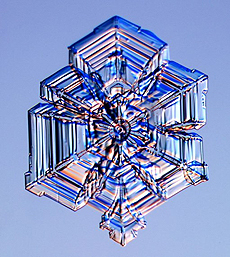Breaking supersymmetry
 |
| Like supersymmetry, most snowflakes are nearly, but not exactly, symmetric. Image: SnowCrystals.com |
Read the expanded column on broken supersymmetry.
At its smallest scale, nature is highly symmetric. There are many different kinds of symmetries among particles— for instance, matter and antimatter are identical except for charge, like an image in a mirror that is the same as its object, but reversed. Photons of the electromagnetic force and Z bosons of the weak force differ only in mass. One could say that particle physics is really the study of nature's symmetries.
It should be no surprise, then, that physicists are seeking new symmetries to understand the universe at a deeper level. Supersymmetry is a hypothetical symmetry between matter and forces— if correct, matter and forces would be two sides of the same coin.
Exact supersymmetry would be very simple: Each particle of matter would have a corresponding particle of force with the same mass, such as quarks and "squarks" (supersymmetric quarks). However, no such thing has been observed. If it exists, supersymmetry must be inexact— quarks and squarks would have different masses, much like the inexact symmetry between massless photons and massive Z bosons. Supersymmetry's attractiveness is undimmed by this imperfection, however. In fact, broken supersymmetry could explain how our complex world unifies at exceedingly high energies, where the little mass differences between quarks and squarks disappear.
But like a shattered mirror, broken supersymmetry is a messy business. There are more than 100 free parameters— knobs to turn— when describing the way that supersymmetry might be inexact. Each of them predicts different particles and different decay patterns.
To control the chaos, physicists often focus their attention on simple models, in which many of the free parameters are chosen to be equal to each other. The simplest is known as the constrained Minimally Supersymmetric Standard Model, or cMSSM. In this model, there are only five free parameters. When physicists seek supersymmetry, they often cast an eye toward the cMSSM for guidance. At the very least, it provides a concrete way to track progress.
Of the supersymmetry search experiments conducted over the last 30 years, the Large Hadron Collider has done the most to rule out new combinations of the cMSSM parameter values: If the mass of cMSSM squarks were small enough to be within the LHC's energy range, it would have produced them by now. Deciding when to pronounce the model dead is subjective, but there is a great deal of discussion about it, and the prognosis is not good.
What if the cMSSM is truly and finally ruled out? That would be a major milestone, a disappointment perhaps, but the broader subject of supersymmetry would not be closed. Physicists are already rolling up their sleeves and considering more general models of supersymmetry breaking, as well as alternatives to supersymmetry that solve some of the same problems. However this turns out, the picture is not as simple as it might have been.
—Jim Pivarski
Want a phrase defined? Have a question? Email today@fnal.gov.
|